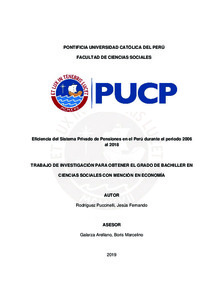| dc.contributor.advisor | Galarza Arellano, Boris Marcelino | |
| dc.contributor.author | Rodríguez Puccinelli, Jesús Fernando | |
| dc.date.accessioned | 2021-07-28T00:07:06Z | |
| dc.date.available | 2021-07-28T00:07:06Z | |
| dc.date.created | 2019 | |
| dc.date.issued | 2021-07-27 | |
| dc.identifier.uri | http://hdl.handle.net/20.500.12404/19802 | |
| dc.description.abstract | Las proyecciones de crecimiento en la Esperanza de Vida de los peruanos, el continuo
incremento de la proporción de la Población Económicamente Activa (PEA) que se afilia a
este sistema y la ampliación del espacio que ocupa en la economía, justifican esta
investigación sobre la eficiencia del desempeño del Sistemas Privado de Pensiones (SPP)
en el Perú. El objetivo de esta investigación es responder si el SPP es eficiente en su
régimen de inversiones. Para ello, se formulan dos interrogantes secundarias: ¿es
indispensable la diversificación en el SPP o existen otras formas? y ¿es óptima la gestión
de portafolio realizada por el SPP? Para hallar la respuesta a estas preguntas, primero, se
toma en cuenta la regulación impuesta al SPP por parte de instituciones como el BCR y la
SBS. El enfoque sobre esta normativa está principalmente orientado a los límites de
inversión que pueden realizar cada AFP según sea el tipo de fondo. Segundo, las
metodologías planteadas para responder a la primera y segunda pregunta son el Ratio de
Sharpe y el Modelo de Markowitz, respectivamente. Por un lado, se hallará el Ratio de
Sharpe para cada fondo y el resultado será comparado con el Ratio de Sharpe del índice
Standard & Poor's 500 y al iShares J.P. Morgan USD Emerging Markets Bond Index, aquel
Ratio de Sharpe que sea mayor indicará una mayor rentabilidad para el riesgo asumido.
Por otra parte, a través del Modelo de Markowitz se hallará si los límites de inversiones
crean o no portafolios eficientes. En conclusión, se demuestra que el régimen de
inversiones del SPP no es óptimo y que en términos de costo-beneficio existen otras
opciones en vez de la diversificación hecha por el SPP. | es_ES |
| dc.description.abstract | Projections of growth in the Life Expectancy of Peruvians, the continuous increase in the
proportion of the Economically Active Population (EAP) that joins this system and the
expansion of the space it occupies in the economy, justify this research on efficiency of the
performance of the Private Pension Systems (SPP) in Peru. The objective of this research
is to answer whether the SPP is efficient in its investment regime. To do this, two secondary
questions are asked: is diversification in the SPP essential or are there other ways? And is
the portfolio management carried out by the SPP optimal? To find the answer to these
questions, first, the regulation imposed on the SPP by institutions such as the BCR and the
SBS is taken into account. The focus on this regulation is mainly oriented to the investment
limits that each AFP can make according to the type of fund. Second, the methodologies
proposed to answer the first and second questions are the Sharpe Ratio and the Markowitz
Model, respectively. On the one hand, the Sharpe Ratio for each fund will be found and the
result will be compared with the Sharpe Ratio of the Standard & Poor's 500 index and the
iShares J.P. Morgan USD Emerging Markets Bond Index, whichever Sharpe Ratio is higher
will indicate a higher return for the risk assumed. On the other hand, it will be found through
the Markowitz Model whether or not investment limits create efficient portfolios. In
conclusion, it is shown that the investment regime of the SPP is not optimal and that in terms
of cost-benefit there are other options instead of the diversification made by the SPP. | es_ES |
| dc.language.iso | spa | es_ES |
| dc.publisher | Pontificia Universidad Católica del Perú | es_ES |
| dc.rights | info:eu-repo/semantics/openAccess | es_ES |
| dc.rights.uri | http://creativecommons.org/licenses/by-sa/2.5/pe/ | * |
| dc.subject | Sistema Privado de Pensiones (Perú) | es_ES |
| dc.subject | Inversiones--Perú--Modelos econométricos | es_ES |
| dc.subject | Pensiones--Tasa de rendimiento--Perú | es_ES |
| dc.subject | Riesgo (Economía)--Perú | es_ES |
| dc.title | Eficiencia del Sistema Privado de Pensiones en el Perú durante el periodo 2006 al 2018 | es_ES |
| dc.type | info:eu-repo/semantics/bachelorThesis | es_ES |
| thesis.degree.name | Bachiller en Ciencias Sociales con mención en Economía | es_ES |
| thesis.degree.level | Bachillerato | es_ES |
| thesis.degree.grantor | Pontificia Universidad Católica del Perú. Facultad de Ciencias Sociales | es_ES |
| thesis.degree.discipline | Ciencias Sociales con mención en Economía | es_ES |
| renati.advisor.dni | 8154581 | |
| renati.advisor.orcid | https://orcid.org/0000-0002-8930-7468 | es_ES |
| renati.author.dni | 71787673 | |
| renati.discipline | 311016 | es_ES |
| renati.level | https://purl.org/pe-repo/renati/level#bachiller | es_ES |
| renati.type | https://purl.org/pe-repo/renati/type#trabajoDeInvestigacion | es_ES |
| dc.publisher.country | PE | es_ES |
| dc.subject.ocde | http://purl.org/pe-repo/ocde/ford#5.02.01 | es_ES |






